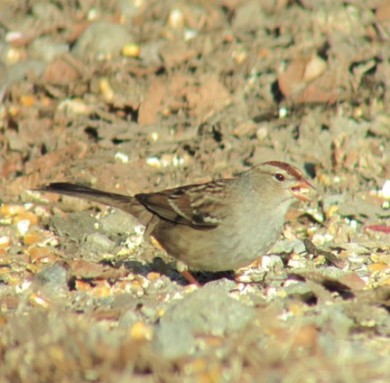
A first year Gambel’s White-crowned Sparrow. Distinguished from Leucophrys by the head pattern – particularly the lateral crown stripe and loral patterns. This bird appeared about two weeks after the main passage season for White-crowned Sparrows, which initially alerted the observers to the possibility of Gambelii. Observers: Hector Galbraith, Taj Scottland, David Johnson, Jo Anne Russo.
Just about everyone who enters their bird data on Vermont eBird, a project of the Vermont Atlas of Life, is no doubt aware that some species can be identified in the field to recognizable races, Red-shafted and Yellow-shafted flickers or Eastern and Western Palm warblers are well-known examples. Although some species can be easily separated into races (but by no means all of them! Some are quite tricky.), many observers do not record their birds down to race when possible. So, most observations of, for example, Palm Warbler are simply recorded as generic ‘palms’.
Why do otherwise? We lose a lot of information that can help elucidate patterns of migration and occurrence of birds from different parts of the continent. Palm Warbler is a good example. By recording to race over the last few years, New England birders have been able to clarify temporal and distributional patterns in the migrations of both races through our area. These were not really understood until recently. So, we advance our understanding of bird migration. Second, it is possible that some of what we now know as races might be full species in a few years (the recent elevation of Cackling Goose is a good example). If we note races now, it will be easier to evaluate occurrence of birds when and if they are split. Lastly, by focusing down on races we add to our repertoire of birding skills. Think of the bragging rights and adulation you get when you tell your companions that you are looking at a Gambel’s White-crowned Sparrow, and not just any old white-crowned!
A small number of Vermont birders have been assiduously assigning birds to races over the last few years. Now, we would like to encourage the spread of this among a wider group of birders. Vermont eBird gives us the opportunity for this by providing race in the eBird checklist for many species (check out Palm Warbler and Yellow-rumped Warbler on the Vermont eBird checklist for an example).
The Vermont Bird Records Committee (VBRC) is increasingly receiving records of races in the state (recent examples include the Greenland race of the Northern Wheatear, Eurasian Green-winged Teal, and the aforementioned Gambel’s White-crowned Sparrow. From these submitted records we are gaining a better understanding of just which races occur when and how rare, or common, they are. In an attempt to widen this behavior among Vermont birders, VBRC has drawn up a list of races for which they would like to see Rare Species Documentation forms being submitted. Take a look at this and think about how much you would like to add to our knowledge by reporting the races in the list. Fame and glory await you.
Thank you.
Hector Galbraith, Alan Strong, Spencer Hardy, Kent McFarland
VBRC race subcommittee
Races Requiring Rare Species Documentation Forms
- Greater white-fronted goose: elgasi (tundra). May occur in the Northeast. Evidence not completely compelling yet.
- Canada goose: parvipes (lesser Canada). May occur, but variability in resident and migrant Canadas make ID problematic.
- Cackling goose: taverneri (Taverner’s). Has been claimed on at least two occasions from Massachusetts and possibly seen once (but not reported to VBRC) in southern VT.
- Black brant: nigricans. Has been recorded in MA.
- Green-winged teal: crecca (common aka Eurasian teal). 1-2 records from VT. Probably under-recorded.
- Red-tailed Hawk—western and/or dark-morphs are a possibility having been seen in western Mass and New York
- Willet: western (inornata), eastern (semipalmata). Most willets occurring in VT likely to be westerns, but not known for sure.
- Short-billed dowitcher: hendersoni. About 10% of autumn coastal birds are this race. Likely to occur in VT.
- Whimbrel: birds of European race (phaeopus) should be looked for and reported. May have been recorded in MA.
- Iceland gull: glaucoides race. Most, if not all, L. glaucoides reported in VT are called “Iceland”, but are more likely to be Kumliens gulls. Icelands (glaucoides) may rarely occur but this needs verification.
- Lesser black-backed gull: any race other than graellsii. Possible that other European races occur, most likely intermedius.
- Mew/Common/Kamchatka gull. brachyrhynchus, canus, and kamtschatschensis, respectively. Most in northeast probably common, but mew gull is possible (recorded in MA), as is Kamchatka (recorded in northeast).
- Northern flicker: red-shafted. Do red-shafteds occur in VT? Intergrades have been recorded at banding stations in MA.
- Horned lark: any race other than praticola (Hoyti and alpestris most likely). Both Hoyti and alpestris recorded in NH. Probably under-recorded.
- Northern wheatear: any claims of Greenland race (leucorhoa). Most northern wheaters seen in VT are most likely to be of this race. Unfortunately, few are identified to subspecies.
- Yellow-rumped warbler: any claims of Audubon’s. Recorded in other New England states, usually in midwinter at feeding stations.
- Savannah sparrow: Ipswich race. Mainly coastal, but has been recorded inland in MA. Possibly under-recorded?
- Fox sparrow: any race other than iliaca. One of the dark races may have been seen in NH, but record may be a melanistic iliaca.
- White-crowned sparrow: gambelii race
- Nelson’s sparrow: any claims of subvirgatus need documentation and review.
- Dark-eyed junco: any race other than slate-colored
- Common redpoll: rostrata (greater redpoll). Under recorded?
- Hoary redpoll: hornemanni may have already been photographed in the state and should be watched for closely.
